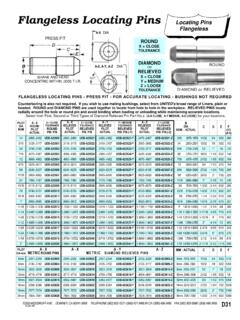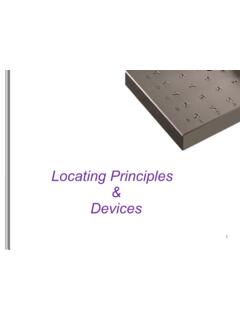Transcription of Locating and Correcting Soft Foot - dac-3d.com
1 Course 208-500 Coupling/Shaft Alignment 07/01/98 Exercise 1998 Design Assistance Corporation 04-1 Exercise and Correcting soft foot Objective Given the DAC Coupling/Shaft Alignment Trainer, hand tools,a magnetic base/dial indicator set and coupling alignment tools,measure and correct for equipment soft foot using twomethods.
2 Performance Standard Reduce soft foot on the motor element to less than .003" at allfoot locations, while following the indicated procedures in theproper Competencies Use of hand tools. Use of a dial indicator (Exercise E208-S02). Understanding of coupling alignment and coupling terminology(Exercise E208-S01).Required Background Reading IPT s Industrial Trades Training Manual, pgs. 407-412 (DAC,#510-MAN).Tools Required Combination wrench set. Hex wrench set. Rule, 6". Socket wrench with a 9/16" socket. Magnetic base/dial indicator set (DAC, #208-015 suggested).
3 Thickness gage. Tin snips. Course 208-500 Coupling/Shaft Alignment 07/01/98 Exercise 1998 Design Assistance Corporation 04-2 Scissors Coupling alignment tool kit, including a dial indicator, shaftclamp, indicator accessories.
4 And an inspection mirror. ( DAC,#208-001 suggested). Pencil and Required DAC Coupling / Shaft Alignment Trainer, #208. Coupling / Shaft Alignment Trainer Use Guide, #208-500. Elastomeric element coupling (DAC, #208-007 suggested). Shim kit (DAC, #208-003 suggested).Introductory DiscussionOne of the most important pre-checks to be performed prior to precisioncoupling alignment is the measurement and correction of equipment soft foot . Softfoot, also called short foot , short leg, angular foot , and bent foot , is a term appliedto a machinery condition where all the supporting feet of an equipment componentare not in complete contact with their respective mounting pads.
5 Uncorrected softfoot can result in several equipment problems including: the loosening of hold-downbolts, metal fatigue at the foot , baseplate twisting, the warping of the equipmentcasings causing internal misalignment and component failure, and the inability toproperly align equipment due to shifting of center lines when tightening hold-downbolts. Most importantly, with regard to coupling alignment, is the tendency for shaftcenterline position to change when hold-down bolts at soft foot locations foot is often described and illustrated as a condition where one foot issimply shorter than other feet on an equipment component.
6 Unfortunately, thissimple circumstance is rare. More often individual feet are bent and therefore notparallel with their mating mounting pad, or mounting pads are warped causing allfeet to be angled relative to their respective pads. soft foot can also be caused byother factors such as: the use of too many shims; dirt or imperfections on shims, feetand baseplate; and finally, stresses from other components. The results of thesecircumstances are sometimes referred to with terms such as bent foot or squishyfoot . There are several techniques suggested for the detection, measurement, andcorrection of soft foot .
7 This exercise discusses of the method chosen, soft foot correction must be performed ina deliberate and methodical way using precision measuring tools, carefulcraftsmanship, and all the senses. Often the measurement and correction of softfoot in preparation for alignment is more tedious and time consuming that the actualalignment itself. However, precision alignment can not be achieved without first Course 208-500 Coupling/Shaft Alignment 07/01/98 Exercise 1998 Design Assistance Corporation 04-3correcting soft foot .
8 Lastly, many equipment failures related to bearings, shaft seals,mechanical seals, and motors can be eliminated by reducing the stresses causedto equipment casings resulting from soft foot . Performance Steps Warning: When performing alignment in the field, alwayslock out and tag out the power source before undertakingany 1. Prepare the DAC Coupling/Shaft Alignment Trainer for usebased on the instructions provided in the Use Guide. Remove the motor element from its mounting pads. Using a socket wrench, and 9/16" socket, loosen the hex headbolts that mount the motor mounting pads to the baseplate atone mounting pad location.
9 The bolts need not be removedcompletely. From the shim set, select a .020" shim and insertit between the pad and the baseplate at a rear bolt slot in the shim should engage the bolt. Re-tighten the hexhead bolts with the socket wrench. Locate the motor element on the motor mounting pads atposition B. Remove all jacking bolt plates. Install, but do nottighten, the four motor hold-down bolts. Install shafts, if not previously installed, in flanged bearings onthe motor and pump elements. Do not tighten flanged bearingset screws.
10 Install the two elastomeric disc coupling hubs, with shaft keys,on the shafts with the hub faces facing each other. Position thehubs flush with the ends of the shafts. Tighten the hub setscrews. Position the shafts in their flanged bearings leavingapproximately 3 inches between the flange faces. Tighten theflanged bearing set measurement of equipment soft foot . Course 208-500 Coupling/Shaft Alignment 07/01/98 Exercise 1998 Design Assistance Corporation 04-4 Remove all existing shims.








